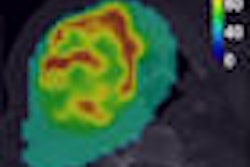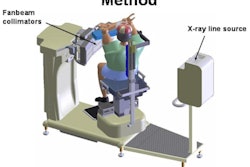Australian researchers involved in a large-scale prospective study have concluded that PET can change the management of more than half of colorectal cancer patients. The study results could be used to expand insurance coverage for PET in the country.
The study comes from the Australian PET Data Collection Project, which was established in 2001 to help the country's government determine if reimbursement should be provided for certain PET indications in cancer, epilepsy, and myocardial viability.
Over the past five to six years, the project has collected data on every patient in Australia who has had cancer. Of approximately 30,000 patients in the database, Dr. Andrew M. Scott, director of the Centre for PET at Austin Hospital in Melbourne, said researchers have found "a substantial change in disease in roughly one-quarter of the patients who had a PET scan."
Results of the study appear in the September issue of the Journal of Nuclear Medicine (September 2008, Vol. 49:9, pp. 1451-1457).
The prospective study analyzed 191 eligible patients from November 2003 to August 2004 at four Australian PET centers: Royal Prince Alfred Hospital in Sydney, Austin Hospital in Melbourne, MIA Moorabbin in Melbourne, and Wesley Hospital in Brisbane.
Eligible patients
Researchers divided the colorectal cancer patients into two groups. Group A consisted of 93 patients with lesions equivocal for recurrent tumor. Their median age was 66 years, ranging from 26 to 85 years, and the group consisted of 54 men and 39 women. Additional sites of disease were identified in 45 of 93 patients (48%).
Based on the PET scan, 61 patients (66%) had their management plans changed. Referring clinicians rated the impact of PET on patient management as high in 60 cases (64%), medium in five cases (5%), and low in 24 cases (26%); they also rated no impact for four patients (5%).
Follow-up data within group A showed that PET detected progressive disease in 56 patients (60%) with additional lesions. In 37 patients (36%), there were no additional lesions detected by PET.
Group B included 98 patients with potentially resectable liver or lung metastases. The mean age among the 64 men and 34 women was 66 years, ranging from 45 to 82 years. Additional sites of disease were identified in 43 of 98 patients (44%). In one patient, no lesions were identified, either before PET or after PET.
Forty-eight patients (49%) had a change in management plan based on the PET scan. Referring physicians rated the impact of PET on patient management as high in 41 cases (42%), medium for five patients (5%), low in 44 cases (45%), and as no impact for eight patients (8%).
Progressive disease was identified in 66 patients (66%) within group B, with additional lesions detected by PET. In 39 patients (39%), there were no additional lesions detected by PET.
An unexpected impact
Scott said researchers did not expect the "extent to which PET was able to impact management change" of treatment. Prior research has shown that PET may influence treatment decisions in approximately one-third of patients.
In group A, "almost two-thirds of patients had their management clearly and unambiguously changed by PET," he added. "In patients with disease that was thought to be present in the lungs or in the liver, approximately one-half of those patients had their management by their treating oncologists changed by the PET scan."
In addition, the Australian study found that the detection of additional sites of the disease predicted outcomes in patients much more accurately than previous screenings. "In other words, PET can not only say what is the best treatment, but can indicate much more accurately what the likely prognosis of the patient is," Scott said. "This also can inform whether management is appropriate or not."
Treatment plans
For the 93 patients in group A, 57 patients received treatment as planned post-PET, while 35 patients received treatment that differed from what was planned. In 33 of the 35 cases, treatment was consistent with the PET results. The treatment was not consistent for two patients, as PET was false-positive in one patient and false-negative in another.
Among the 98 patients in group B, there were 68 patients whose treatment was as planned post-PET and 29 patients whose treatment differed from what was planned. Of those 29 patients, the treatment implemented was consistent overall with the PET results in 24 cases. PET was false-negative for lesions in three patients. In two of those three cases, CT also was false-negative, and PET missed an adrenal lesion confirmed on subsequent CT in the third patient.
Thus, overall, the management plan actually implemented was consistent with the stated post-PET management plan in 96% of patients.
Researchers noted some limitations of the study. For example, physicians were asked to indicate their planned management without PET, which, the study read, "may not always have been the actual management that occurred in the absence of PET. Patients were generally referred from outside institutions to the PET centers. Therefore, prognostic factors, such as the time between initial diagnosis and tumor recurrence, could not always be recorded, and multivariate analyses including the PET findings were not possible."
Medicare reimbursement
The Australian PET Data Collection Project has completed and submitted its work on eight prospective studies to the Australian government. Three of the indications -- colorectal cancer, malignant melanoma, and ovarian cancer -- have been reviewed and "are likely to be made available through Medicare in Australia," Scott said. "We are expecting that [approval] in the next one to two months."
Project researchers also have submitted data and regulatory reviews currently are underway for head and neck cancer, lymphoma, gastric and stomach cancer, glioma, and sarcomas. "They all show that PET can clearly change management and can impact outcomes in prospective multicenter studies," Scott said.
PET's efficacy results from the Australian studies are proving very similar to data gathered by the U.S. National Oncologic PET Registry (NOPR) in its quest to have more cancer indications for PET reimbursed in the U.S. Scott said the two projects have been exchanging information and collaborating on methods of acquisition and analysis of the respective data.
"Data which is generated from our study or the U.S. study is extremely relevant to all countries, if they decide to implement PET in their populations," he added. "The more we all work to generate evidence-based data which can justify the use of PET, the more likely we will see funding in all those countries."
By Wayne Forrest
AuntMinnie.com staff writer
September 2, 2008
Related Reading
FDG-PET changes treatment plans for glioma patients, June 26, 2008
FDG-PET is effective for diagnosing spinal tumors, April 9, 2008
Study shows benefits of very delayed cerebral FDG-PET imaging, December 21, 2007
PET changes oncology management, study shows, July 19, 2007
PET trumps MRI for brain cancer chemo response, July 7, 2006
Dual-tracer PET possible for cerebral gliomas, June 5, 2006
Copyright © 2008 AuntMinnie.com



















